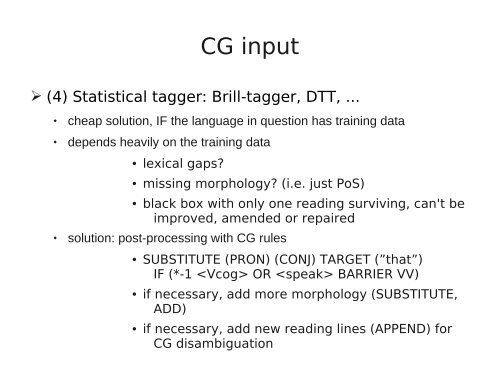On how to write rules in Constraint Grammar (CG-3) - VISL
On how to write rules in Constraint Grammar (CG-3) - VISL
On how to write rules in Constraint Grammar (CG-3) - VISL
Create successful ePaper yourself
Turn your PDF publications into a flip-book with our unique Google optimized e-Paper software.
<strong>CG</strong> <strong>in</strong>put<br />
➢ (4) Statistical tagger: Brill-tagger, DTT, ...<br />
<br />
<br />
<br />
cheap solution, IF the language <strong>in</strong> question has tra<strong>in</strong><strong>in</strong>g data<br />
depends heavily on the tra<strong>in</strong><strong>in</strong>g data<br />
●<br />
●<br />
●<br />
lexical gaps?<br />
miss<strong>in</strong>g morphology? (i.e. just PoS)<br />
black box with only one read<strong>in</strong>g surviv<strong>in</strong>g, can't be<br />
improved, amended or repaired<br />
solution: post-process<strong>in</strong>g with <strong>CG</strong> <strong>rules</strong><br />
●<br />
●<br />
●<br />
SUBSTITUTE (PRON) (CONJ) TARGET (”that”)<br />
IF (*-1 OR BARRIER VV)<br />
if necessary, add more morphology (SUBSTITUTE,<br />
ADD)<br />
if necessary, add new read<strong>in</strong>g l<strong>in</strong>es (APPEND) for<br />
<strong>CG</strong> disambiguation
















